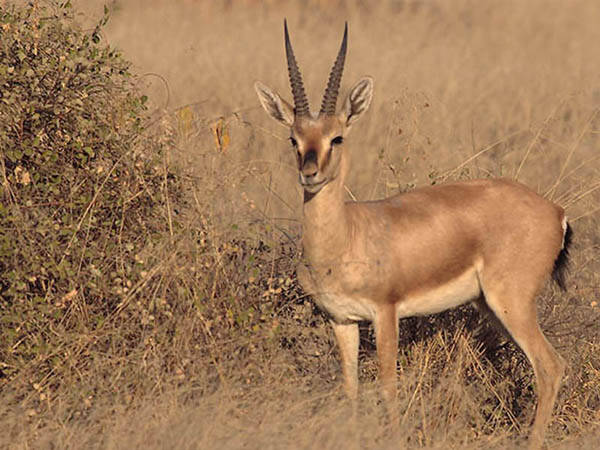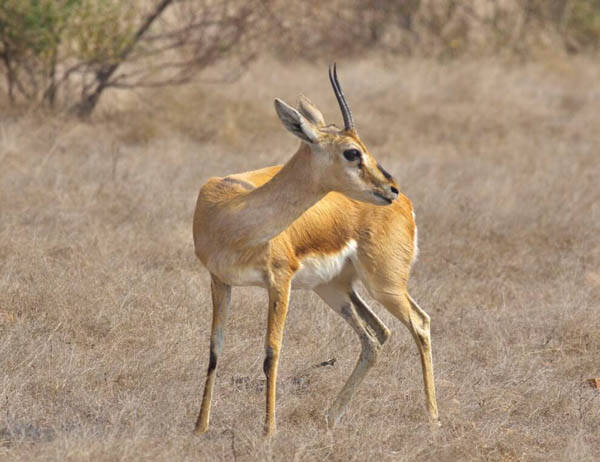Gazella bennetti
IUCN
LCBasic Information
Scientific classification
- name:Gazella bennetti
- Scientific Name:Gazella bennetti
- Outline:Ungulata
- Family:Artiodactyla Bovidae Gazelle
Vital signs
- length:90-120cm
- Weight:20-25kg
- lifetime:10-20years
Feature
The skull is fairly short and flat, with an elongated premaxilla that is slightly curved.
Distribution and Habitat
Distributed in Afghanistan, India, Iran and Pakistan. It lives mainly in the northwestern region of Rajasthan, India. Their distribution ranges from south of the Krishia River, through central India, to the north-central region of Iran, east of the Zagros Mountains and south of the Alborz. The Indian gazelle distributed in western Rajasthan accounts for 60-70% of the global population.
The habitat altitude ranges from sea level to 1500 meters. The species can thrive in a variety of habitats, including dry deciduous forests, open woodlands, sand dunes, plains, hills, semi-arid deserts and arid valleys, living in areas with annual rainfall of 150-750 mm. The species is facultatively hydrophilic and drought-tolerant, and can consume plants to conserve metabolic water in the body, thereby enduring relatively long intervals between each visit to the watering point. They sometimes also feed on rapeseed and sorghum cultivated in desert areas.
Appearance
The Indian gazelle is 0.9-1.2 meters long and 0.6-0.8 meters tall. It weighs 20-25 kilograms. Females weigh less than males and are 10 centimeters shorter. The skull is rather short and flat, with an elongated premaxilla that is slightly curved. The skull has large ear bulbs and teeth. The dentition is outward and curved forward. Both males and females have horns, which are relatively short in females, with distinct rings and tips at right angles, slightly tilted outward. The horns of adult males can reach 250-350 mm. Female horns are usually half the length of male horns, thinner in width, and have fewer prominent rings. The horns of male Baloch and Iranian subspecies average 256.6 mm long, and female horns average 184.7 mm long.
The fur color of the Indian gazelle is sandy, yellowish, and red, with a pale white ventral surface. The facial markings are very distinct, with a dark brown or black forehead, lighter cheeks with dark stripes, and a distinct spotted nose. The fur color ch
Details
Indian Gazelle (scientific name: Gazella bennetti) is also known as Chinkara and Indian Gazelle in foreign languages. There are 6 subspecies.

Indian Gazelle marks its territory on piles of feces. Like other gazelles, adult males are territorial and stay in demarcated areas. They will chase away other males but try to keep visiting females. The territory is demarcated by dung piles, which are used several times by males. Females in estrus are actively guarded by territorial males until mating occurs, after which they may join the female group. Indian gazelles are usually solitary, but sometimes form small groups of 3-4, which include a female and her offspring. Occasionally, large groups of 8-10 individuals are observed. During the breeding season, larger groups are usually observed. The largest group recorded consisted of 25 individuals in July 1987.
Indian gazelles have nocturnal feeding habits and are most active before sunset and throughout the night. They are very agile and flexible animals and can run at a speed of 80 kilometers per hour for 1 hour. They are also timid and shy animals. They retreat into mountains or deserts due to interference with human life, keep a certain distance from agricultural and other human activities, and deliberately avoid motor vehicles. A startled Chinkara stamps its front paws on the ground and emits a sneeze-like hissing sound through its nose, hence the name "Chinkara" (the sneezer).
The diet of Chinkara gazelles usually consists of grasses, various leaves, crops and fruits such as pumpkins and melons. Due to physiological processes, they can go for long periods without drinking water, thus saving metabolic water. Most of their metabolic water intake comes from the vegetation they consume. The shrubs and trees that make up the diet are found in mountains and deciduous forests, while grasses and other herbs are found in valleys and farmlands. In the arid Thar Desert, Chinkara gazelles mainly consume four herbs: Crotalaria burhia (42% of the diet), Zipziphus nummularia (15%), Maytenus emerginata (11%) and Prosopis cineraria (9%). The main predators of the Indian gazelle are golden jackals, Bengal tigers, Iranian wolves, Indian leopards, cheetahs, eagles, and wild dogs in the countryside. The most important natural enemy is humans. Hunting and illegal poaching have greatly reduced the population of the species. Indian gazelles use their speed and perseverance to escape predators and use their horns for defense.

Indian gazelles are polygamous. Males are extremely territorial and use their horns to protect their resources. Fights between males are often observed during the mating season, and males actively defend females from other males before mating. Mating begins when a male touches the female's lower limbs while her legs stiffen (called a "laufschlag"). There are two breeding seasons throughout the year, one at the end of the monsoon season, from late August to early October, and the other in late spring, from March to late April. The gestation period is 5-5.5 months. Females usually give birth to one offspring, but twins have been reported frequently. Most young are born in April, and female Indian gazelles provide direct care for their offspring, with a lactation period of about 2 months. However, some offspring may remain with their mother for up to 12 months while their mother has another offspring.
As of 2001, the Indian gazelle population was estimated at over 100,000 in India, including 80,000 in the Thar Desert, but the species has been declining since then. Populations in Pakistan have declined due to overhunting, and the status in Afghanistan is unknown, but thought to be very rare. There are estimated to be about 1,300 in Iran. Indiscriminate hunting has adversely affected the Indian gazelle in Afghanistan, Iran, and Pakistan. Habitat loss due to overgrazing, shifting to agriculture, and industrial development is also a factor in the species' decline.
The Indian gazelle lives in more than 80 protected areas in India, five in Pakistan, and nine in Iran. In parts of western India, the Indian gazelle is protected by villagers for religious reasons. The species is fully protected by law in India, Pakistan, and Iran.
Listed in the IUCN Red List of Threatened Species in 2016 ver3.1 - Least Concern (LC).
Listed in Appendix I, II and III of the Convention on International Trade in Endangered Species of Wild Fauna and Flora (CITES) 2019 edition Appendix III.
Protect wild animals and eliminate game.
Maintaining ecological balance is everyone's responsibility!








